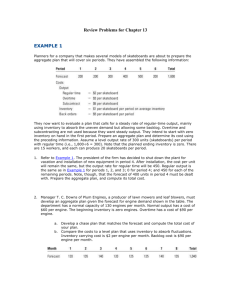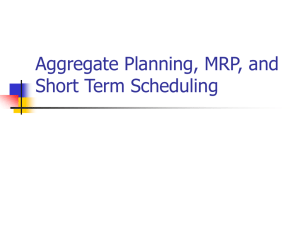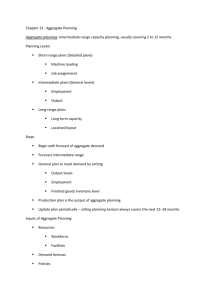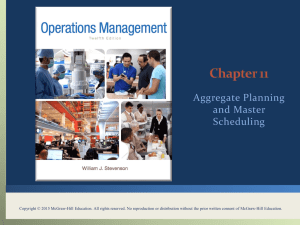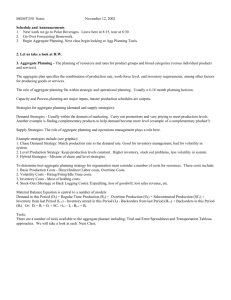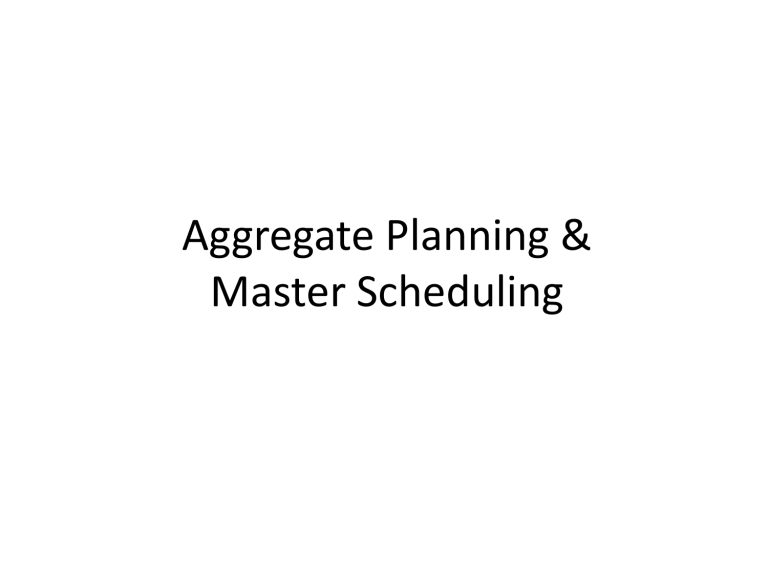
Aggregate Planning & Master Scheduling The Planning Process Long-range plans (over one year) Capacity decisions critical to long range plans Issues: Research and Development New product plans Capital investments Facility location/expansion Top executives Operations managers with sales and operations planning team Operations managers, supervisors, foremen Responsibility Intermediate-range plans (3 to 18 months) Issues: Sales and operations planning Production planning and budgeting Setting employment, inventory, subcontracting levels Analyzing operating plans Short-range plans (up to 3 months) Scheduling techniques Issues: Job assignments Ordering Job scheduling Dispatching Overtime Part-time help Planning tasks and time horizons Sales and Operations Planning • A process of balancing resource and forecasted demand, aligning an organization’s competing demands from supply chain to final customer, while linking strategic planning with operations over all planning horizons. Sales and Operations Planning ▶ Coordination of demand forecasts with functional areas and the supply chain ▶ Typically done by cross-functional teams ▶ Determine which plans are feasible ▶ Limitations must be reflected ▶ Provides warning when resources do not match expectations ▶ Output is an aggregate plan S&OP and the Aggregate Plan Aggregate Planning • An S&OP team builds an aggregate plan that satisfies forecasted demand by adjusting production rates, labor levels, inventory levels, overtime work, subcontracting rates, and other controllable variables. The objective of aggregate planning is usually to meet forecast demand while minimizing cost over the planning period Aggregate planning has certain inevitable pre-required inputs as follows: • Demand forecast for the period for which the planning has to be made. • Information about the resources and the facilities available. • Cost of various alternatives and resources such as cost of holding inventory, ordering cost, cost of production through various production alternatives like subcontracting, backordering and overtime. • Organizational policies regarding the usage of above alternatives. 7 • Aggregate planning is concerned with matching supply and demand of output over the medium time range, up to approximately 3 to 18 months into the future. • The goal of aggregate planning is to achieve a production plan that will effectively utilize the organization’s resources to satisfy expected demand. • Planners must make decision on output rates, employment levels and changes, inventory levels and changes, back orders and subcontracting in or out. 8 • Aggregate planning is actually a ‘big picture’ approach to planning. Planners usually try to avoid focusing on individual product or service-unless the organization has only one major product or service. Instead, they focus on overall demand and the overall capacity they want to provide. • Aggregate planning decisions are strategic decisions that define the framework within which operating decisions will be made. • The Aggregate plan will guide the more detailed planning that eventually leads to a master schedule. The Figure below illustrates the planning sequence. 9 Planning Sequences Corporate strategies and policies Economic, competitive, and political conditions Business plan Aggregate plan Master schedule Aggregate demand forecasts Establishes operations and capacity strategies Establishes Operations capacity Establishes schedules for specific products 10 Aggregate Planning ▶ Combines appropriate resources into general terms ▶ Part of a larger production planning system ▶ Disaggregation breaks the plan down into greater detail ▶ Disaggregation results in a master production schedule Aggregate Planning QUARTER 1 Jan. Feb. March 150,000 120,000 110,000 QUARTER 2 April May June 100,000 130,000 150,000 QUARTER 3 July Aug. Sept. 180,000 150,000 140,000 Importance of Aggregate Planning • Generally speaking, aggregate planning is connected to the budgeting process. Most organizations plan their financial requirements annually on a department-bydepartment basis. • Aggregate planning is important because it can help to synchronize flow throughout the supply chain. • Aggregate planning helps to achieve rough balance between demand and capacity. 13 Aggregate Planning Strategies 1. Should inventories be used to absorb changes in demand? 2. Should changes be accommodated by varying the size of the workforce? 3. Should part-timers, overtime, or idle time be used to absorb changes? 4. Should subcontractors be used and maintain a stable workforce? 5. Should prices or other factors be changed to influence demand? Capacity Options 1. Changing inventory levels ▶ Increase inventory in low demand periods to meet high demand in the future ▶ Increases costs associated with storage, insurance, handling, obsolescence, and capital investment ▶ Shortages may mean lost sales due to long lead times and poor customer service Capacity Options 2. Varying workforce size by hiring or layoffs ▶ Match production rate to demand ▶ Training and separation costs for hiring and laying off workers ▶ New workers may have lower productivity ▶ Laying off workers may lower morale and productivity Capacity Options 3. Varying production rates through overtime or idle time ▶ Allows constant workforce ▶ May be difficult to meet large increases in demand ▶ Overtime can be costly and may drive down productivity ▶ Absorbing idle time may be difficult Capacity Options 4. Subcontracting ▶ Temporary measure during periods of peak demand ▶ May be costly ▶ Assuring quality and timely delivery may be difficult ▶ Exposes your customers to a possible competitor Capacity Options 5. Using part-time workers ▶ Useful for filling unskilled or low skilled positions, especially in services Demand Options 1. Influencing demand – Use advertising or promotion to increase demand in low periods – Attempt to shift demand to slow periods – May not be sufficient to balance demand and capacity Demand Options 2. Back ordering during high-demand periods ▶ Requires customers to wait for an order without loss of goodwill or the order ▶ Most effective when there are few if any substitutes for the product or service ▶ Often results in lost sales Demand Options 3. Counter seasonal product and service mixing ▶ Develop a product mix of counterseasonal items ▶ May lead to products or services outside the company’s areas of expertise Aggregate Planning Options TABLE 13.1 Aggregate Planning Options OPTION Changing inventory levels ADVANTAGES DISADVANTAGES Changes in human resources are gradual or none; no abrupt production changes. Inventory holding cost may increase. Shortages may result in lost sales. Applies mainly to production, not service, operations. Hiring, layoff, and training costs may be significant. Used where size of labor pool is large. Varying Avoids the costs of workforce other alternatives. size by hiring or layoffs COMMENTS Aggregate Planning Options TABLE 13.1 Aggregate Planning Options OPTION ADVANTAGES DISADVANTAGES COMMENTS Varying production rates through overtime or idle time Matches seasonal Overtime premiums; fluctuations tired workers; may without hiring/ not meet demand. training costs. Allows flexibility within the aggregate plan. Subcontracting Permits flexibility and smoothing of the firm’s output. Applies mainly in production settings. Loss of quality control; reduced profits; loss of future business. Aggregate Planning Options TABLE 13.1 Aggregate Planning Options OPTION ADVANTAGES DISADVANTAGES COMMENTS Using parttime workers Is less costly and more flexible than full-time workers. High turnover/ training costs; quality suffers; scheduling difficult. Good for unskilled jobs in areas with large temporary labor pools. Influencing demand Tries to use excess capacity. Discounts draw new customers. Uncertainty in demand. Hard to match demand to supply exactly. Creates marketing ideas. Overbooking used in some businesses. Aggregate Planning Options TABLE 13.1 Aggregate Planning Options OPTION ADVANTAGES DISADVANTAGES COMMENTS Back May avoid ordering overtime. Keeps during high- capacity constant. demand periods Customer must be willing to wait, but goodwill is lost. Many companies back order. CounterFully utilizes seasonal resources; allows product and stable workforce. service mixing May require skills or equipment outside the firm’s areas of expertise. Risky finding products or services with opposite demand patterns. Mixing Options to Develop a Plan ▶ A mixed strategy may be the best way to achieve minimum costs ▶ There are many possible mixed strategies ▶ Finding the optimal plan is not always possible Mixing Options to Develop a Plan ▶ Chase strategy ▶ Match output rates to demand forecast for each period ▶ Vary workforce levels or vary production rate ▶ Favored by many service organizations Mixing Options to Develop a Plan ▶ Level strategy ▶ Daily production is uniform ▶ Use inventory or idle time as buffer ▶ Stable production leads to better quality and productivity ▶ Some combination of capacity options, a mixed strategy, might be the best solution Aggregate Planning Inputs and Output Inputs Outputs Resources: Total cost of a plan Projected levels of inventory Output Employment Subcontracting Backordering Workforce/production rates Facilities and equipments Demand forecast Policies on workforce changes Subcontracting Overtime Inventory levels/changes Backorders Costs: Inventory carrying, Back orders, Hiring /firing, overtime, inventory changes and subcontracting 30 Methods for Aggregate Planning ▶ Graphical Methods ▶ Popular techniques ▶ Easy to understand and use ▶ Trial-and-error approaches that do not guarantee an optimal solution ▶ Require only limited computations Graphical Methods 1. Determine the demand for each period 2. Determine the capacity for regular time, overtime, and subcontracting each period 3. Find labor costs, hiring and layoff costs, and inventory holding costs 4. Consider company policy on workers and stock levels 5. Develop alternative plans and examine their total cost Example A Juarez, Mexico, manufacturer of roofing supplies has developed monthly forecasts for a family of products. Data for the 6-month period January to June are presented in Table below . The firm would like to begin development of an aggregate plan. Monthly Forecasts MONTH Jan Feb Mar Apr May June EXPECTED DEMAND 900 700 800 1,200 1,500 1,100 PRODUCTION DAYS 22 18 21 21 22 20 Roofing Supplier Example Monthly Forecasts MONTH Jan Feb Mar Apr May June EXPECTED DEMAND 900 700 800 1,200 1,500 1,100 6,200 Average requirement PRODUCTION DAYS 22 18 21 21 22 20 124 Total expected demand = Number of production days 6,200 = = 50 units per day 124 DEMAND PER DAY (COMPUTED) 41 39 38 57 68 55 Roofing Supplier Example Production rate per working day Forecast demand 70 – 60 – Level production using average monthly forecast demand 50 – 40 – 30 – 0 – Jan Feb Mar Apr May June 22 18 21 21 22 20 = Month = Number of working days Alternatives • Plan 1: To maintain a constant workforce throughout the 6-month period. • Plan 2: To maintain a constant workforce at a level necessary to meet the lowest demand month (March) and to meet all demand above this level by subcontracting. • Plan 3: To hire and lay off workers as needed to produce exact monthly requirements PLAN 1 FOR THE ROOFING SUPPLIER—A CONSTANT WORKFORCE Cost Information Inventory carrying cost Subcontracting cost per unit Average pay rate Overtime pay rate Labor-hours to produce a unit Cost of increasing daily production rate (hiring and training) Cost of decreasing daily production rate (layoffs) $ 5 per unit per month $20 per unit $10 per hour ($80 per day) $17 per hour (above 8 hours per day) 1.6 hours per unit $300 per unit $600 per unit assume that • 50 units are produced per day (8 hr) and that we have a constant workforce, no overtime or idle time, no safety stock, and no subcontractors. • The firm accumulates inventory during the slack period of demand, January through March, and depletes it during the higher-demand warm season, April through June. • Beginning inventory = 0 and planned ending inventory = 0. Roofing Supplier Plan 1 MONTH PRODUCTION DAYS PRODUCTION AT 50 UNITS PER DAY Jan 22 1,100 900 +200 200 Feb 18 900 700 +200 400 Mar 21 1,050 800 +250 650 Apr 21 1,050 1,200 –150 500 May 22 1,100 1,500 –400 100 June 20 1,000 1,100 –100 0 DEMAND FORECAST MONTHLY INVENTORY CHANGE ENDING INVENTORY 1,850 Total units of inventory carried over from one month to the next = 1,850 units Workforce required to produce 50 units per day = 10 workers Roofing Supplier Plan 1 COST PRODUCTION MONTHLY CALCULATIONS AT 50 UNITS DEMAND INVENTORY ENDING PER $9,250 DAY FORECAST INVENTORY (= 1,850 unitsCHANGE carried x $5 per MONTH Inventory PRODUCTION DAYS carrying Jan 22 1,100 900 unit) +200 200 Feb 18 900 700 +200 400 Mar 21 Apr 21 1,050 1,200 –150 500 1,100 1,500 –400 100 1,000 1,100 –100 0 Regular-time labor Other May costs (overtime, 22 hiring, layoffs, June 20 subcontracting) Total cost 99,200 (= 10 workers x $80 per day x 124 1,050 800 +250 650 days) 0 $108,450 1,850 PLAN 2 FOR THE ROOFING SUPPLIER—USE OF SUBCONTRACTORS WITHIN A CONSTANT WORKFORCE In-house production = 38 units per day x 124 days = 4,712 units Subcontract units COST Regular-time labor Subcontracting Total cost = 6,200 – 4,712 = 1,488 units CALCULATIONS $75,392 (= 7.6 workers x $80 per day x 124 days) 29,760 (= 1,488 units x $20 per unit) $105,152 Roofing Supplier Plan 2 Production rate per working day Forecast demand 70 – Level production using lowest monthly forecast demand 60 – 50 – 40 – 30 – 0 – Jan Feb Mar Apr May June 22 18 21 21 22 20 = Month = Number of working days Roofing Supplier Plan 3 Cost Computations for Plan 3 MONTH FORECAST (UNITS) DAILY PROD RATE BASIC PRODUCTI ON COST (DEMAND X 1.6 HRS per UNIT X $10/HR) EXTRA COST OF INCREASING PRODUCTIO N (HIRING COST) EXTRA COST OF DECREASING PRODUCTIO N (LAYOFF COST) TOTAL COST Jan 900 41 $ 14,400 — — $ 14,400 Feb 700 39 11,200 — $1,200 (= 2 x $600) 12,400 Mar 800 38 12,800 — $600 (= 1 x $600) 13,400 Apr 1,200 57 19,200 $5,700 (= 19 x $300) — 24,900 May 1,500 68 24,000 $3,300 (= 11 x $300) — 24,300 June 1,100 55 17,600 — $7,800 (= 13 x $600) 25,400 $99,200 $9,000 $9,600 $117,800 Roofing Supplier Plan 3 Production rate per working day Forecast demand and monthly production 70 – 60 – 50 – 40 – 30 – 0 – Jan Feb Mar Apr May June 22 18 21 21 22 20 = Month = Number of working days Comparison of Three Plans Comparison of the Three Plans COST PLAN 1 Inventory carrying $ 9,250 Regular labor 99,200 Overtime labor 0 Hiring 0 Layoffs 0 Subcontracting 0 Total cost $108,450 PLAN 2 $ 0 75,392 0 0 0 29,760 $105,152 Plan 2 is the lowest cost option PLAN 3 $ 0 99,200 0 9,000 9,600 0 $117,800 An Example of an Aggregate Planning • Planners for a company that makes several models of skateboards are about to prepare the aggregate plan that will cover 6 periods. They have the following information: • • • • • • • • • Period 1 2 3 4 5 6 Forecast 200 200 300 400 500 200 Costs Output Regular time = $2 per skateboard Overtime = $3 per skateboard Subcontract = $6 per skateboard Inventory = $1 per skateboard per period on average inventory Backorders = $5 per skateboard per period 45 An Example of an Aggregate Planning • They want to evaluate a plan that calls for a steady rate of regular output, mainly using inventory to absorb the uneven demand but allowing some backlog. • Overtime and subcontracting are not used because they want steady output. • They intend to start with 0 inventory on hand in the first period. • Prepare an aggregate plan and determine its cost using information provided. Assume a level of output rate of 300 units per period with regular time (1800/6 = 300). • Note that the planned ending inventory is 0. There are 15 workers, and each of them can produce 20 units per period. 46 Solution to the Problem • • • • • • • • • • • • Period 1 Forecast 200 Output Regular 300 Overtime -Subcontract -Output – Forecast 100 Inventory Beginning 0 Ending 100 Average 50 Backorder 0 2 200 300 --100 100 200 150 0 3 300 300 --0 200 200 200 0 4 400 5 500 300 300 -----100 -200 200 100 150 0 100 0 50 100 6 200 300 --100 0 0 0 0 Total 1800 1800 0 600 100 47 Solution to the Problem • Period • Cost • Output • Regular • Overtime • Subcontract • Hire/Layoff • Inventory • Backorder • Total 1 2 600 ---50 0 650 600 ---150 0 750 3 600 ---200 0 800 4 5 6 Total 600 ---150 0 750 600 ---50 500 1150 600 3600 ---0 600 0 500 600 4700 48 Extension of the Previous Example Problem • After reviewing the plan developed in the preceding example, the planners have decided to develop an alternative plan. • They have learnt that one person is about to retire from the company. • Rather than replacing that person, they would like to stay with smaller workforce and use overtime to make up for the lost output. • The reduced regular time output is 280 units per period. The maximum amount of overtime output per period is 40 units. • Develop a plan and compare it with the previous one. 49 Solution to the Extended Problem • • • • • • • • • • • • • • • • • • • • • Period Forecast Output Regular Overtime Subcontract Output – Forecast Inventory Beginning Ending Average Backorder Cost Output Regular Overtime Subcontract Hire/Layoff Inventory Backorder Total 1 200 2 200 3 300 4 400 5 500 6 200 Total 1800 280 0 -80 280 0 -80 280 280 40 40 --20 -80 280 40 --180 280 0 -80 1680 120 0 80 40 0 80 160 120 0 160 180 170 0 100 0 50 80 0 0 0 0 560 0 --40 0 600 560 0 --120 0 680 560 560 120 120 ----170 140 0 0 850 820 180 100 140 0 560 120 --50 400 1130 560 0 --0 0 560 0 520 80 3360 360 520 400 4640 50 Minimal Cost Solution to an Aggregate Plan by Transportation Modeling • • • • • • • • • • • • • Period 1 2 Demand 550 700 Capacity Regular 500 500 Overtime 50 50 Subcontract 120 120 Beginning Inventory 100 Costs Regular 60 per unit Overtime 80 per unit Subcontract 90 per unit Inventory carrying cost 1 per unit Backorder cost 3 per unit 3 750 500 50 100 • Set up this problem in a transportation table and solve for the minimum cost plan 51 Solution to the problem by transportation modeling Demand for Supply from Period 1 2 3 Period 1 Period 2 Beginning inventory 100 Regular time 450 60 Overtime Period 3 Total capacity available (supply) Unused capacity 1 2 0 100 50 61 62 0 500 80 50 81 82 0 50 subcontract 90 30 91 92 0 120 Regular time 63 500 60 61 0 500 Overtime 83 50 80 81 0 50 subcontract 93 20 90 100 91 0 120 Regular time 66 63 500 60 0 500 Overtime 86 83 50 80 0 50 subcontract 96 93 100 90 0 100 Demand 550 0 700 750 90 90 2090 52 Aggregate Planning in Services • Aggregate planning for services takes into account projected customer demand, equipment capacities, and labor capabilities. The resulting plan is a time based projection. • In this category of planning, • 1. Services occur when they are rendered. Unlike manufacturing output, most services can’t be inventoried. • 2. Demand for service can be difficult to predict. Demand for services is often quite variable. • 3. Capacity availability can be difficult to predict. Processing requirements for services can sometimes be quite variable. • 4. Labor flexibility can be an advantage in services. Labor often comprise a significant portion of service compared to manufacturing. • 53 Some Examples of Aggregate Planning in Services • Hospitals: Hospitals use aggregate planning to allocate funds, staff, and supplies to meet demand of medical services of patients. • Airlines: Aggregate planning in Airline is quite complex due to wide range of factors such as planes, flight personnel, ground personnel, multiple routs, landing/departure sites, seat allocation etc. • Restaurants: Aggregate planning deals with smoothing the service rate, determining the size of the workforce, managing demand to match a fixed capacity. The general approach usually involves building inventory during slack period and depleting it during peak period. • Other services: Financial, hospitality, transportation, recreation etc. provide a high volume , intangible output. They involve managing demand and HR requirements. 54 Disaggregating the Aggregate Planning • Disaggregating the aggregate plan means breaking down the aggregate plan into specific product requirement in order to determine requirements of labor (skills, size of workforce), materials and inventory. • The result of disaggregating the aggregate plan is a master schedule showing the quantity and timing of requirement of the specific end items for a scheduled horizon.(usually 6 to 8 weeks ahead). • The master schedule contains important information for marketing as well as for production. An overview of the context of disaggregation is shown below: Aggregate Planning Disaggregation Master Schedule Moving from the aggregate plan to a master schedule 55 An example of a master schedule • Aggregate Plan Month January February March Output 200 300 400 • Master schedule Month January February March Push 100 100 100 Self- propelled 75 150 200 Riding 25 50 100 Total 200 300 400 Output Category 56 Master Scheduling • A master schedule indicates the quantity and delivery times for a product or a group of products, but it does not show planned production. • Tasks of master scheduling are as follows: • 1. Evaluating impacts of new orders. • 2. Providing delivery dates for orders • 3. Dealing with problems as follows: • a. Evaluating the impact of production delays or late • • • • • • deliveries of purchased goods. b. Revising the master schedule when necessary because of insufficient supplies or capacity. c. Bringing instances of insufficient capacity to the attention of production and marketing personnel so that they can resolve them. 57 Master Scheduling • Once a tentative master schedule has been developed, it must be validated. This is an extremely important step. Validation is referred to as rough-cut-capacity (RCCP) planning. • RCCP is a approximate balancing of capacity and demand to test the feasibility of a master schedule. • Inputs: The beginning inventory, forecast for each scheduled period, and committed customers orders. • Output: Determination of the projected inventory, production requirements, and the resulting uncommitted inventory (Available-to-promise inventory, ATP) 58 An Example of Master Scheduling • A company that makes industrial pumps wants to prepare master production schedule for June and July. Marketing has forecasted demand of 120 pumps for June and 160 for July. These have been evenly distributed over the four weeks in each month as shown in the table below: Weekly forecast for industrial pump June Period Forecast 1 30 2 30 3 30 July 4 30 5 40 6 40 7 40 8 40 • Beginning inventory is 64 units. • 59 An Example of Master Scheduling 8-Week schedule showing forecast, customers orders, beginning inventory and projected on-hand inventory Beginning inventory = 64 June July Period 1 2 3 4 5 6 7 8 Forecast 30 30 30 30 40 40 40 40 Customer orders 33 20 10 4 2 Projected on-hand inventory 31 1 -29 • Projected on-hand inventory = Available Inventory (AI) - larger of the forecast and customer order 60 An Example of Master Scheduling Determination of the Master Production Schedule (MPS) and projected on-hand inventory Week Inventory from previous week Requirements Net inventory before MPS 1 2 3 4 5 6 7 8 64 31 1 41 11 41 1 31 33 30 30 30 40 40 40 40 31 1 -29 11 -29 1 -39 -9 MPS (70) Projected inventory 70 70 70 70 31 1 41 11 41 1 31 61 • Requirements = larger of the forecast and customer order 61 An Example of Master Scheduling Projected on-hand inventory and MPS Beginning inventory = 64 June • July Period 1 2 3 4 5 6 7 8 Forecast 30 30 30 30 40 40 40 40 Customer orders 33 20 10 4 2 Projected on-hand inventory 31 1 41 11 41 1 31 61 70 70 MPS 70 70 Requirement = larger of the forecast and customer order 62 An Example of Master Scheduling The available-to-promise inventory Beginning inventory = 64 June July Period 1 2 3 4 5 6 7 8 Forecast 30 30 30 30 40 40 40 40 Customer orders 33 20 10 4 2 Projected on-hand inventory 31 1 41 11 41 1 31 61 MPS ATP inventory 11 70 70 70 70 56 68 70 70 • ATP = AI - Sum of customers orders in weeks until an MPS quantity appears 63 Time Fences in Master Scheduling • Changes to a master schedule can be disruptive. • Time fences points in time that separate phases of a master schedule planning horizon. • Time fences divide a scheduling time horizon into three sections as shown in the figure below: Master scheduled periods 1 2 3 Frozen (firm or fixed) 4 5 6 slushy (somewhat firm) 7 8 9 liquid (open) 64 Time Fences in Master Scheduling • Frozen Periods: The near-term phase where the delivery of a new product is impossible, or only possible incurring a very high cost or with an extraordinary options such as delaying another order. • Slushy periods: This phase is next to the frozen phase, may be extend to few periods. Order entry in this phase necessitates trade-offs, but is less costly or disruptive than in the frozen phase. • Liquid periods: They are farthest out of on the master scheduling horizon. New orders or cancellations are easier here. • A key element in the success of MPS is the strict adherence to the time fence policies and rules. 65
